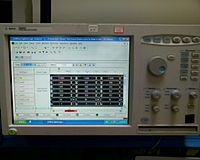- Logic analyzer
-
Logic analyzer 
Logic analyzerA logic analyzer is an electronic instrument which displays signals in a digital circuit. A logic analyzer may convert the captured data into timing diagrams, protocol decodes, state machine traces, assembly language, or correlate assembly with source-level software.
Presently, there are three distinct categories of logic analyzers available on the market:
- The first is mainframes, which consist of a chassis containing the display, controls, control computer, and multiple slots into which the actual data-capturing hardware is installed.
- The second category is standalone units, which integrate everything into a single package, with options installed at the factory.
- The third category is PC-based logic analyzers. The hardware connects to a computer through a USB or Ethernet connection, and then relays the captured signals to the software on the computer. These devices are typically much smaller and less expensive, because they do not need dedicated displays or hardware input, such as keyboards or knobs.
Mixed-signal oscilloscopes combine the functionality of a digital storage oscilloscope with a logic analyzer. The several benefits of these include the ability to view analog and digital signals together in time, and to trigger on either digital or analog signals and capture on the other.
Operation
A logic analyzer may be triggered on a complicated sequence of digital events, and then capture a large amount of digital data from the system under test (SUT).
When logic analyzers first came into use, it was common to attach several hundred "clips" to a digital system. Later, specialized connectors came into use. The evolution of logic analyzer probes has led to a common footprint that multiple vendors support, which provides added freedom to end users. Introduced in April, 2002, connectorless technology (identified by several vendor-specific trade names: Compression Probing; Soft Touch; D-Max) has become popular. These probes provide a durable, reliable mechanical and electrical connection between the probe and the circuit board with less than 0.5 to 0.7 pF loading per signal.
Once the probes are connected, the user programs the analyzer with the names of each signal, and can group several signals together for easier manipulation. Next, a capture mode is chosen, either "timing" mode, where the input signals are sampled at regular intervals based on an internal or external clock source, or "state" mode, where one or more of the signals are defined as "clocks", and data are taken on the rising or falling edges of these clocks, optionally using other signals to qualify these clocks.
After the mode is chosen, a trigger condition must be set. A trigger condition can range from simple (such as triggering on a rising or falling edge of a single signal) to the very complex (such as configuring the analyzer to decode the higher levels of the TCP/IP stack and triggering on a certain HTTP packet).
At this point, the user sets the analyzer to "run" mode, either triggering once, or repeatedly triggering.
Once the data are captured, they can be displayed several ways, from the simple (showing waveforms or state listings) to the complex (showing decoded Ethernet protocol traffic). Some analyzers can also operate in a "compare" mode, where they compare each captured data set to a previously recorded data set, and halt capture or visually notify the operator when this data set is either matched or not. This is useful for long-term empirical testing. Recent analyzers can even be set to email a copy of the test data to the engineer on a successful trigger.
Uses
Many digital designs, including those of ICs, are simulated to detect defects before the unit is constructed. The simulation usually provides logic analysis displays. Often, complex discrete logic is verified by simulating inputs and testing outputs using boundary scan. Logic analyzers can uncover hardware defects that are not found in simulation. These problems are typically too difficult to model in simulation, or too time consuming to simulate and often cross multiple clock domains.
Field-programmable gate arrays have become a common measurement point for logic analyzers.
See also
Categories:- Digital electronics
- Embedded systems
- Electronic test equipment
Wikimedia Foundation. 2010.
